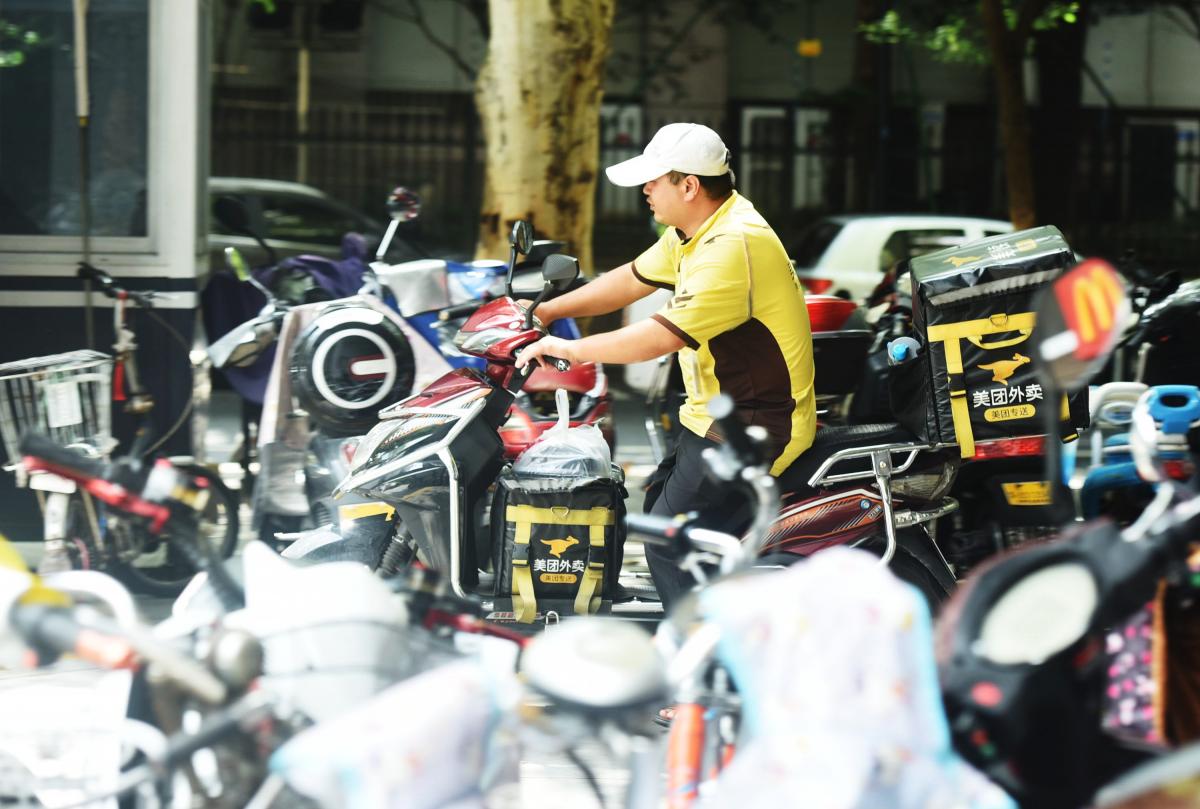In early September, China’s two main food delivery platforms, Meituan and Ele.me, were stunned by an expose in People (人物) magazine of the intense working conditions endured by industry employees on a daily basis.
The article (外卖骑手,困在系统里) revealed in detail how food delivery workers were essentially slaves to the algorithm, with little or no chance of meeting the targets set by the platforms. This led to drivers taking extreme risks to beat traffic and endless disputes with both restaurants and customers.

These problems have been exacerbated by the cutthroat competition between Meituan and Ele.me in their bid for market domination, which began in earnest in 2016. To attract more customers, the platforms increased spending and reduced prices, recouping their losses by cutting driver remuneration and increasing the fines for late deliveries.
The impact of these policies can be seen both in the number of collective protests and accidents involving food delivery workers. China Labour Bulletin’s Strike Map recorded 45 strikes and protests by food delivery workers in 2019, compared with just ten in 2017. In addition, the Work Accident Map has recorded 121 accidents involving food delivery workers since 2018, including 19 in which the workers died.
The public outrage generated by the People article led to the platforms making what appeared to be, on the surface at least, some concessions to the workforce. On 10 September, Ele.me said it would give customers the option of waiting another five minutes to give drivers more breathing space, while Meituan said it would increase its delivery time by eight minutes.
However, food delivery workers were unimpressed with these “concessions,” which only shifted the burden back onto consumers, saying they failed to deal with the fundamental problems embedded in the current industry model, and could even make the problems for the drivers worse.
Drivers told Southern Metropolis Daily that giving them an additional five to ten minutes’ delivery time was not very helpful if the restaurant was slow in producing the meal and made the driver wait. Restaurants, also losing profits to the industry, currently have just ten minutes to produce the order once it is placed, putting intense pressure on both the restaurant and the delivery worker. Other workers pointed out that customers often caused delays as well. “Sometimes an office building will not allow deliveries so you have to call the customer to come down and collect it. If the customer takes 20 minutes to come down, what can you say? All subsequent deliveries will be late,” one worker told CCTV Finance.
The drivers proposed very concrete solutions to these problems, such as having restaurants delay issuing their bill until the order is ready so that drivers do not have to wait for long periods, and for key destinations such as offices and hospitals to install delivery boxes that would save the driver and customer time. If Ele.me followed up on these suggestions, many disputes could be mitigated, they said.
Meituan’s additional eight minutes seemed like more of a genuine compromise but, in reality, was just another public relations gimmick. In a short video post on social media, a food delivery worker using the name 外送江湖骑士联盟盟主, pointed out that the change was actually just a matter of the difference between the display time for delivery drivers and customers. For Meituan delivery drivers, the delivery time had always been 38 minutes. Previously, customers were told the delivery time was 30 minutes so as to give drivers eight minutes leeway before implementation of the late delivery penalty. The only change was that customers now know it is really 38 minutes. “It is old wine in a new bottle,” the delivery worker said.
The driver, like many of his colleagues, argued that the most important issue that had yet to be addressed was the platforms’ arbitrary adjustment of order delivery prices. In Beijing, for example, he said, drivers used to earn more than eight yuan for a three kilometre delivery, but now that amount had dropped to barely five yuan. This meant drivers had to take more orders to earn the same amount of money, putting them even more at risk of accidents.
The platforms say their pricing structure is determined by the algorithm, but the key point is that the algorithm is inherently hostile to the drivers, and food delivery workers have absolutely no say in how it operates.
The only way for workers to gain a voice in how the system operates is by organizing. The All-China Federation of Trade Unions (ACFTU) has included food delivery workers in its list of Eight Major Groups that are now said to be the union’s priority. Since 2018, the ACFTU says 6.5 million new members have been recruited from the Eight Major Groups. So far, however, the union has done little to help its new members other than provide skills training, legal assistance and some medical benefits. Nothing has been done to challenge the power monopoly currently held by the food delivery companies.
Since the People expose, more pressure is being placed on the ACFTU to get its act together. Jia Xijin, the deputy director of the Institute of Public Welfare Organizations and Social Governance of Tsinghua University, was quoted by CCTV news as saying food delivery workers should form some kind of collective organization to make their voices heard and protect their legal rights.
And the driver who posted the video explaining the eight minute concession also expressed the hope that the authorities could take the lead in setting up a union-like organization for drivers that could negotiate with the platforms and allow local government departments set the standards for the industry, rather than arbitrary pronouncements from private companies like Meituan and Ele.me.
